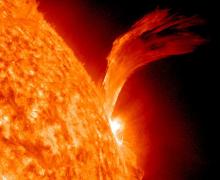Last night I watched a movie that ends with the complete destruction of Earth at the hands of a "killer solar flare." (To avoid spoilers, I won't mention which movie. Google "2009 movie solar flare" if you simply must know.) Naturally I was curious: could this really happen?
(Actually, "curious" isn't really the word. As a child, when I learned that 5 billion years from now the sun will expand and swallow the Earth in a fiery death, I didn't really understand what "5 billion years" really meant. I had nightmares about it for months - nightmares much like the one the little boy has in the movie. Accidental childhood terror alert: triggered!)
I was also concerned, because the movie kept using the phrase "coronal mass ejection" to talk about this extinction-level event. But coronal mass ejections, while rare, do happen - and without destroying the entire planet. So what's the deal, here?
First, we have to define our terms. A lot of people are throwing around the phrase "killer solar flare" and "extinction level event" when what they really mean is a Carrington Event. This is a solar flare so extreme that it wipes out all electronics on the planet. That's pretty extreme! But it would knock us back to the stone age. It wouldn't knock us off the planet, much less burn the planet to cinders.
Killer flares have been observed in other suns. In 2006, NASA observed a killer flare happening 135 light-years away, as the star II Pegasi blasted out an explosion the equivalent of 500 million trillion atomic bombs. A flare that size would indeed destroy the Earth, but comparing II Pegasi to our own sun is like comparing apples to oranges. II Pegasi is a "violent red giant star with a binary partner in very close orbit." Calling II Pegasi is "unstable" is the understatement of the solar system.
Our sun, on the other hand, is a nice stable yellow dwarf.
Coronal mass ejections happen when an unusually strong solar flare kicks a chunk of plasma off the sun and flings it out into space. When these super-flares are timed just right, they can intersect with Earth. We recently saw a coronal mass ejection happen on August 1, 2010. It created an impressive light show of aurora in the night sky extending (in North America) as far south as Utah.
A coronal mass ejection was also responsible for the aforementioned Carrington Event. It caused a lot of problems with our infrastructure on the time. But destroying all life on Earth? No need to worry!
(Actually, "curious" isn't really the word. As a child, when I learned that 5 billion years from now the sun will expand and swallow the Earth in a fiery death, I didn't really understand what "5 billion years" really meant. I had nightmares about it for months - nightmares much like the one the little boy has in the movie. Accidental childhood terror alert: triggered!)
I was also concerned, because the movie kept using the phrase "coronal mass ejection" to talk about this extinction-level event. But coronal mass ejections, while rare, do happen - and without destroying the entire planet. So what's the deal, here?
First, we have to define our terms. A lot of people are throwing around the phrase "killer solar flare" and "extinction level event" when what they really mean is a Carrington Event. This is a solar flare so extreme that it wipes out all electronics on the planet. That's pretty extreme! But it would knock us back to the stone age. It wouldn't knock us off the planet, much less burn the planet to cinders.
Killer flares have been observed in other suns. In 2006, NASA observed a killer flare happening 135 light-years away, as the star II Pegasi blasted out an explosion the equivalent of 500 million trillion atomic bombs. A flare that size would indeed destroy the Earth, but comparing II Pegasi to our own sun is like comparing apples to oranges. II Pegasi is a "violent red giant star with a binary partner in very close orbit." Calling II Pegasi is "unstable" is the understatement of the solar system.
Our sun, on the other hand, is a nice stable yellow dwarf.
Coronal mass ejections happen when an unusually strong solar flare kicks a chunk of plasma off the sun and flings it out into space. When these super-flares are timed just right, they can intersect with Earth. We recently saw a coronal mass ejection happen on August 1, 2010. It created an impressive light show of aurora in the night sky extending (in North America) as far south as Utah.
A coronal mass ejection was also responsible for the aforementioned Carrington Event. It caused a lot of problems with our infrastructure on the time. But destroying all life on Earth? No need to worry!
